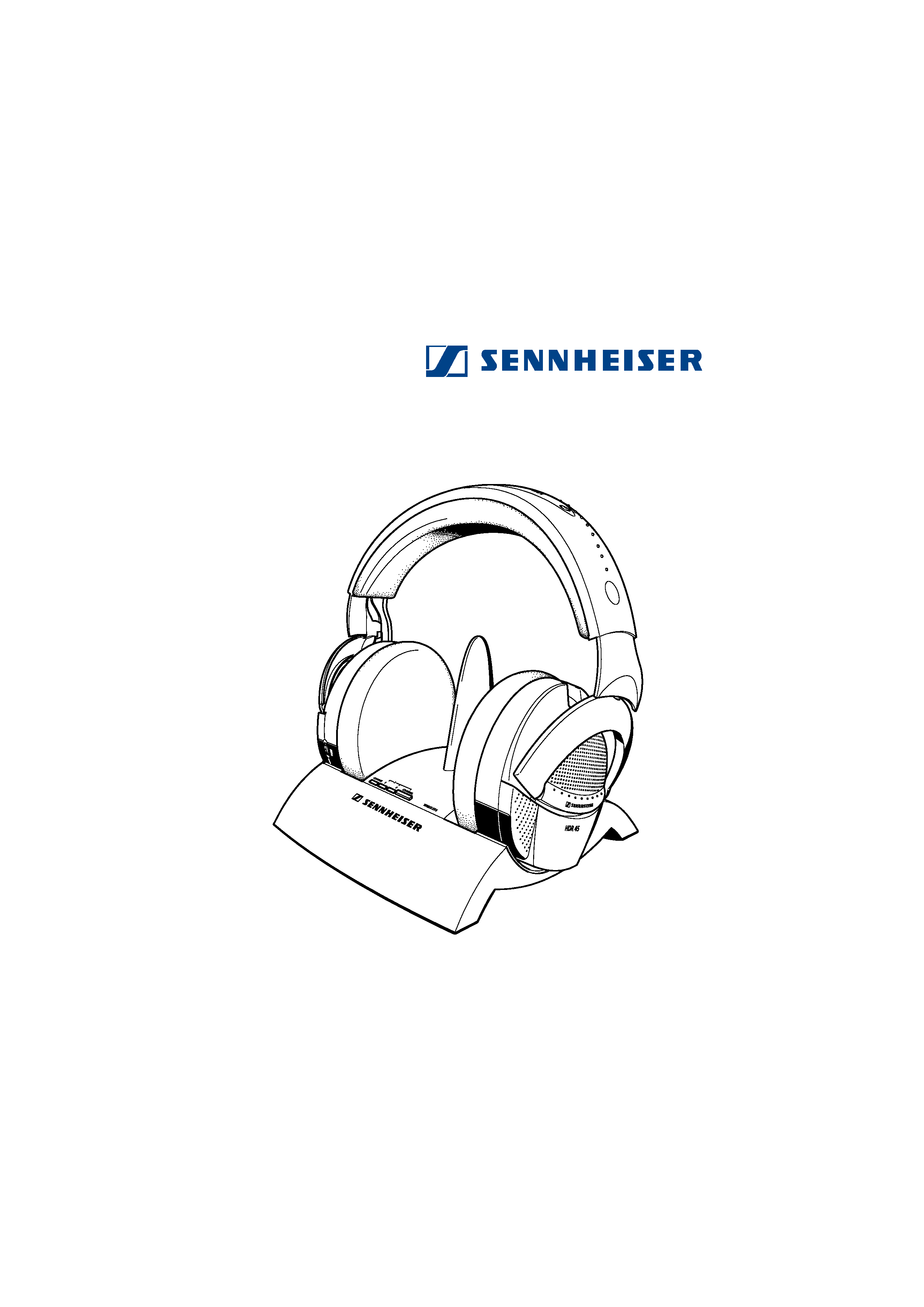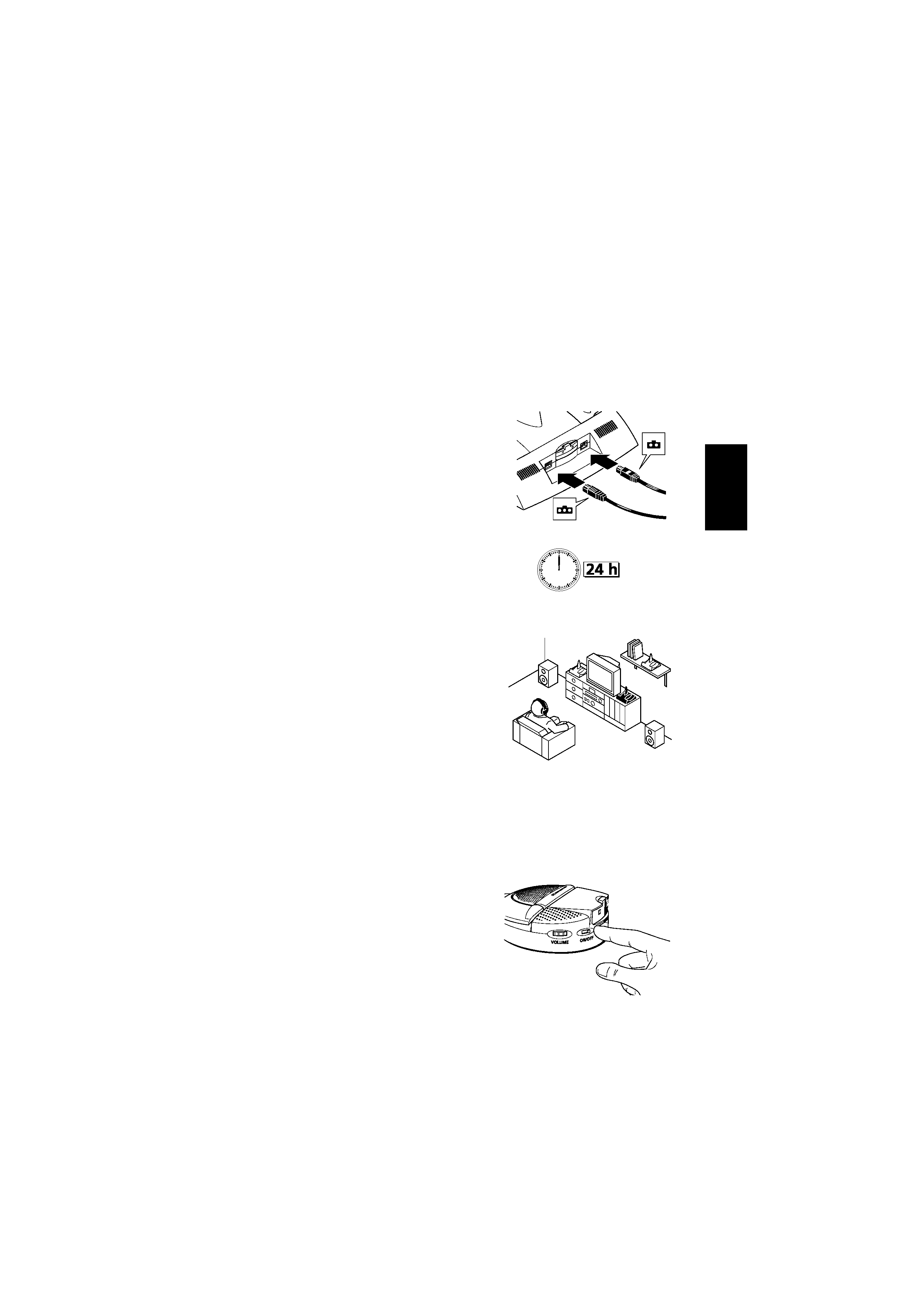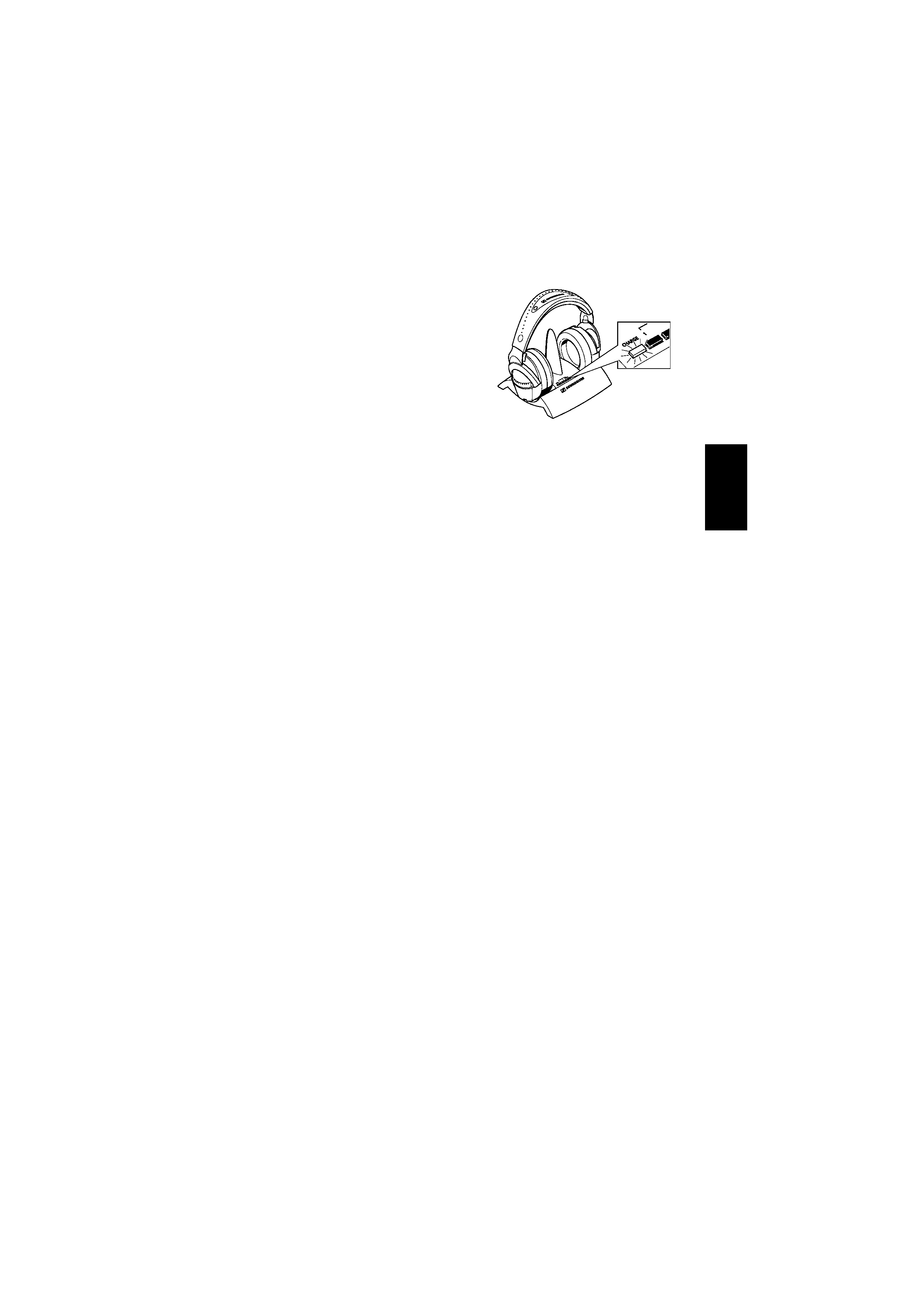
GEBRAUCHSANLEITUNG
INSTRUCTION MANUAL
NOTICE D´EMPLOI
ISTRUZIONI PER L´USO
INSTRUCIONES PARA EL USO
GEBRUIKSAANWIJZING
Wireless RS 45
CoverHDR45.fm Seite 1 Dienstag, 7. Januar 2003 1:09 13

Wireless RS 45-7
English
Wireless RS 45
Thank you for choosing Sennheiser! Over half a century of accumulated expertise
in the design and manufacture of high-quality electro-acoustic equipment have
made Sennheiser a world-leading company in this field. We have designed this
product to give you reliable operation over many years.
Please take a few moments to read these instructions carefully, as we want you to
enjoy your new Sennheiser product quickly and to the full.
System components and connections
Before proceeding, please check and make sure
the system components shown are all present and
correct (see illustration inside cover page).
Establish the necessary connections.
Charge the accupack for 24 hours before you
use it for the first time! (Please refer to the
section Charging the accupack.)
Where to place the transmitter
Choose a suitable place near your hi-fi system
or TV set.
Do not place the transmitter close to metal
objects such as shelf bars, reinforced concrete
walls, etc.
The transmitter features a convenient automatic
on/off function. The transmitter is switched on
by the audio signal. If there is no audio signal for
about 3 minutes, the transmitter automatically switches off. The transmitter is now
in stand-by mode, its power consumption is very low so that it can remain
connected to the mains. Accupacks can always be recharged when the transmitter
is connected to the mains.
Switching the headphone receiver on
The ON/OFF switch is on the right earpiece.
Switching the headphone receiver off
Make sure to switch off the headphones after
each use and store the headphones in the
transmitter's charging compartment to avoid
discharging the accupack.

Wireless RS 45-8
E
ngl
is
h
Adjusting the volume
Set the volume of your sound source to a
medium value. With some devices, the volume
for the headphone output can be regulated
separately.
Use the VOLUME control on the right earpiece to
adjust the headphones´ volume.
Adjusting the receiver channel
First switch on the transmitter (see section Where
to place the transmitter). Then switch on the
headphone receiver - as soon as the receiver is
switched on it automatically tunes itself to the first
strong signal found (normally the transmitter
frequency). If, for some reason, the selected
channel is not the correct one (eg: because of
interference or another nearby system), press the
TUNE button on the earpiece and the auto-tune function will re-tune to the next
strong signal. Repeat this until you can hear the audio signal loud and clear. If you
decide to change the transmitter channel, the receiver search tuning must be re-
started by pressing the TUNE button on the headphones again.
Changing the transmission channel
To avoid interference caused by the
simultaneous operation of several transmitters,
select a different channel on each transmitter.
Depending on the system variant, two or three
switchable transmission channels are available.
To select a channel, press the CHANNEL button
until the desired LED or LED combination lights
up:
LED 1
channel 1 active
LED 2
channel 2 active
LED 1 and 2
channel 3 active (except 863 MHz version).
Complete freedom of movement
It is not necessary that transmitter and
headphone receiver are in a direct line of sight,
so you can move around freely in the home or
outside in the garden. One transmitter can be
used to transmit to several receivers on the
same frequency.
Additional headphones with the designation
HDR 45 are available from your specialist
dealer. Please make sure to choose
headphones with the same frequency range as
the transmitter you are using (see type plate on the bottom of the transmitter).

Wireless RS 45-9
English
Charging the accupack
For charging the accupack, place the
headphones into the transmitter's charging
compartment (nb: make sure the headphones
are inserted the correct way round. The
Sennheiser logo on the headband must be
readable looking from the front - see diagram.
The charging contacts are on the RH earpiece
of the headphones - these are placed on the
corresponding contacts in the LH indentation of
the transmitter, the one next to the "charge" light). The red LED on the transmitter
must light up to show charging is taking place.
Always store the headphones on the transmitter to ensure that they are fully
charged when they are needed. The headphones are automatically switched off
by the charging process.
BA 151 spare accupack
When the headphones' accupack is going flat (noise, interference and distortion
are sure signs of a flat accupack), recharge the accupack. After an initial charging
of 24 hours, the normal charging time is 14 hours. A fully charged accupack has
an operating time of more than four hours.
If you wish to use your headphones for more than four hours of continuous
operation, we recommend purchasing a spare accupack. Always store the spare
accupack in the charging compartment at the back of the transmitter to ensure that
it is fully charged when it is needed. Only use original Sennheiser accupacks
accupacks from other manufacturers may cause damage to your headphones and
will invalidate the guarantee.
Additional BA 151 spare accupacks can be charged via the L 151-2 charger
(available from your specialist dealer).
Before disposing of an old and exhausted accupack, make sure that it is totally
discharged by using it until the device switches off. To protect the environment,
only dispose of totally exhausted accupacks.
Additional information
The audio transmission technology used with this device is basically that of a
radio. According to today's scientific knowledge, the radio waves emitted by this
device are not harmful to humans or animals.
ATTENTION: LISTENING AT HIGH VOLUME LEVELS FOR LONG PERIODS
CAN PERMANENTLY DAMAGE YOUR HEARING.
This device has been designed for use with stereo devices. For connection to
mono devices, please use a stereo to mono jack plug available from most audio
accessory shops.
Use a soft cloth or, if necessary, a damp wash-leather for cleaning the devices. Do
not use aggressive cleansing agents.

Wireless RS 45-10
E
ngl
is
h
Varnish or furniture polish may attack the rubber feet of the transmitter's charging
unit. As these could stain your furniture, place the transmitter on a non-slip pad.
If problems occur...
Are all connections properly made?
Are the headphones and sound source switched on and is the volume
correctly adjusted?
Have you charged the accupack for at least 20 minutes?
Are you too far from the transmitter? (if so, move closer)
Choose a different channel.
Adjust the setting with the TUNE button.
If the problem persists, please contact your specialist dealer for assistance.
Never open the device!
Only use original Sennheiser spare parts and accessories. Components from
other manufacturers (e.g. for mains unit or accupack) may cause damage to the
device and will invalidate the guarantee.
Accessories
The following accessories are available from your specialist dealer:
Spare accupack
BA 151
Charger
L 151-2
Additional headphones
HDR 45
Technical data
Modulation
FM, stereo
Transmitter
Power supply
12 V DC via plug-in mains unit
Power consumption
approx. 1 VA
RF output power
typ. up to 10 mW
(0.75 mW with 925 MHz version)
Signal-to-noise ratio
typ. > 68 dBA
Frequency range
see type plate located on the bottom
of transmitter
Channels
3 (2 with 863 MHz version)
Audio connector
3.5 mm /1/4" (6.3 mm) stereo jack plug,
(925 MHz version supplied with jack
to 2 x phono plug)
Charging compartments
1, for BA 151 accupack
Weight
approx. 186 g incl. accupack
Dimensions
approx. 155 x 153 x 105 mm
Receiver
Max. sound pressure level
96 dB
THD
< 0.7 % (at 1 kHz and nom. deviation)
Power supply
2.4 V via BA 151 accupack
Current consumption
approx. 19.5 mA
Operating time
more than 4 hrs per accupack
Weight
approx. 160 g incl. accupack
Dimensions
approx. 150 x 80 x 200 mm
